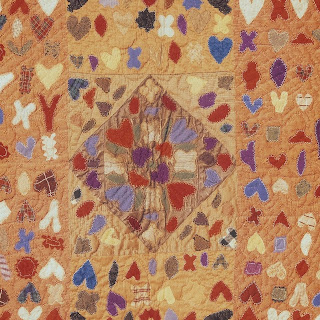Having bought the 1930's North Country bed jacket from Jen Jones, I was surprised to see another listed by Louise Bell of Builth Wells in Wales.This item is of a similar age, but is constructed differently, with a thinner, silkier fabric and a different style of quilting. The colours are more gentle and there is a most attractive two tone ruffle on the neck.
You can see that the jacket is blue on the outside and has a pink lining. Its in good condition, but has been well used, with wear to be seen in one or two areas (but nothing too major).
The quilting is a straight grid, with some double lined roses and leaves on a vine down either side of the front.
The back is plainly quilted with a grid. The stitching is neatly done....
There is little wadding and the jacket is lightweight. The outer pieces have been sewn together on the machine, and then the inner seams slip stitched in place by hand. A bit different to the last bed jacket where the seams were hand sewn together through all layers and then the edges slip stitched down....no piping to the edges, here...
Here, rather than a ribbon tie, the closure is a matching fabric loop and a pretty mother of pearl button. The edges are all neatly hand sewn in the Welsh fashion.
The neck ruffle is very feminine and would have taken some skill to achieve. This item has no provenance, but was bought in Carmarthen. Between and after the wars, many items were made to be used around the house, or to be given away as gifts. Large quilts were not often made although there were some quilting classes run by groups like the WI.
An interesting addition to the collection!






























